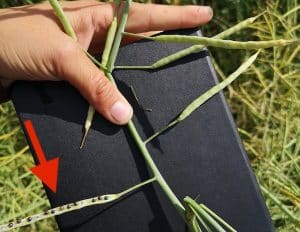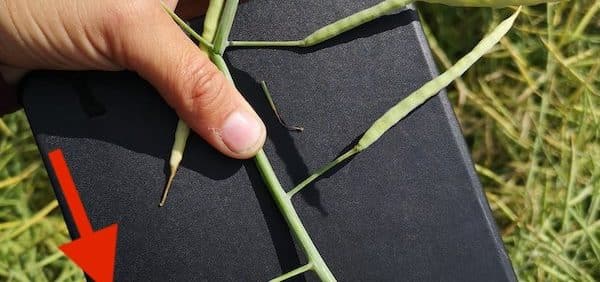Canola fields swathed at 60% seed colour change (SCC) on the main stem can yield 8% more than fields swathed at 30% SCC. Read ‘Swath later for a big boost in yield‘. The spread was shown to be even wider with low plant populations, with more yield on side branches.
Run the numbers. Sticking with the 8% difference and assuming a decent plant population (best case scenario), if a field will yield 40 bu./ac. when cut at 30% SCC, it would yield 43 bu./ac if cut at 60% SCC. Seed colour change will typically increase about 10% every two to three days (less under hot dry conditions, more under cool moist conditions) so waiting a week can provide a big boost in yield and potential profit.

What about quality? Quality difference between swathing at 30% SCC and 60% SCC is most often minimal. Seed chlorophyll content, which is the major quality factor to consider when it comes to harvest timing, tends to be elevated in two harvest scenarios: (1) heavy frost locks in green for immature seeds; (2) swathing the crop too early (with minimal seed colour change) and on a hot day can cause the crop to cure too fast for green to clear.
Frost forecast. Swathing too early in anticipation of a frost is rarely a good move because, to be effective, it has to be done three good curing days ahead of the frost. This can backfire because you’re locking in a yield loss in anticipation of a heavy frost that may not occur. Check out the ‘managing fall frost events‘ section of the current Canola Harvest Guide. Read ‘Frost in forecast: swath now or leave it standing?’
Why would a farmer cut canola early? Maybe the farmer has a lot of acres to harvest and, with the calendar flipping to September, wants to get things moving. If farmers really want to (or have to) swath some fields early, we’d recommend they start with fields where more of the seeds in side branches are firm and where overall field maturity is relatively even. Fields that are uneven (with a lot of mushy seeds in side branches) would be best left to mature a little more – especially if the canola has a pod-shatter tolerance trait.
Early swathing and harvest timing. Swathed canola can be ready to combine earlier than standing canola, but swathing earlier does not necessarily mean combining earlier. Canola swathed green takes a lot longer to cure than canola swathed at 60% seed colour change, and by cutting early, the crop may not meet its yield potential. For canola left standing for straight combining, desiccants (diquat/Reglone) will not speed-up seed maturity, but they can speed up crop dry-down and make it possible to get into the field sooner. Note the important distinction: There is a big difference between maturity and dry-down. Desiccants shut down the plant and basically STOP it from maturing, which can lock in high green seed levels and end the finishing opportunity for latest seeds if applied prematurely. Read more.
